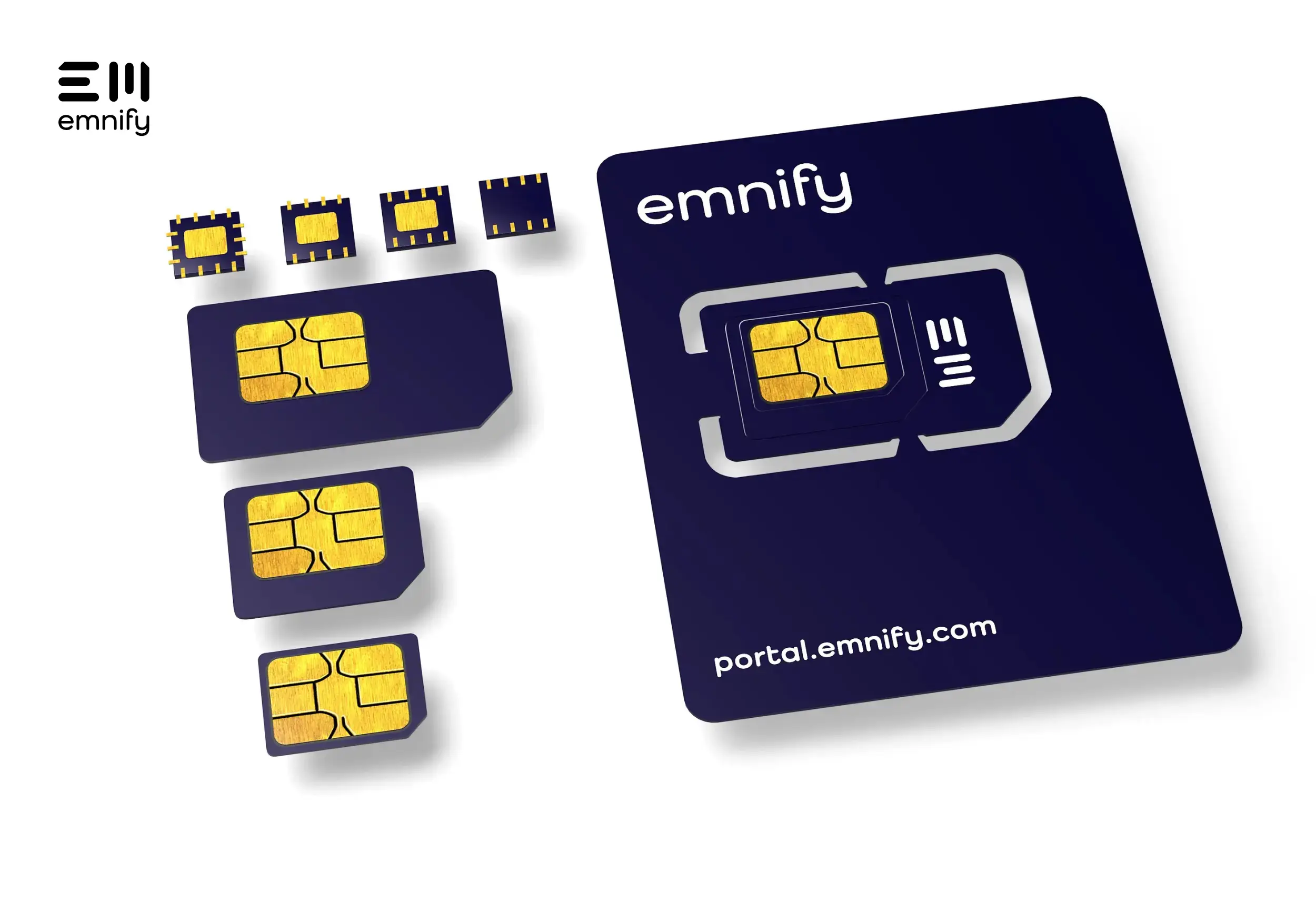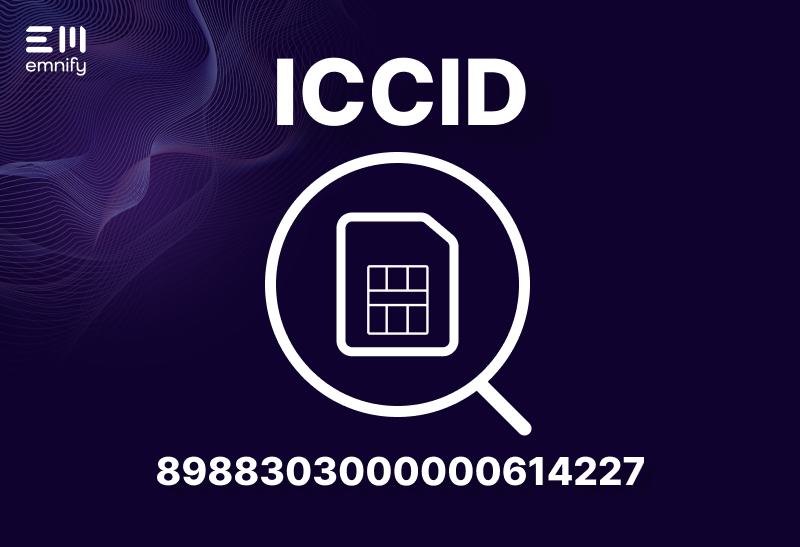

Your devices need to stay connected wherever your customers are, not just where your carrier happens to have coverage or roaming agreements.
If you are deploying globally, multi-IMSI SIMs are your best bet. We'll explain why, but first, let's start with the basics.
Table of Contents
- What is an IMSI?
- How to check the IMSI number of IoT devices
- Single IMSI SIMs
- Multi-IMSI SIMs
- How changing IMSIs works
- So what about eUICCs?
- Which option is best for you?
- Multi-IMSIs are the right choice
What is an IMSI?
IMSI stands for International Mobile Subscriber Identity—essentially, it’s the unique code that lets mobile networks know who you are.
Every cellular-enabled IoT device has this number stored on its SIM card, and it’s usually 15 digits long. When your device tries to connect to a network, the IMSI is what lets the mobile network operator (MNO) know which subscriber it’s dealing with.
Once identified, your device can access not only the MNO’s network but also any other networks they have roaming agreements with.
How are IMSI numbers structured?
IMSI numbers have three distinct parts:
- Mobile Country Code (MCC): Used to identify the country where a subscriber is primarily located; 2–3 digits
- Mobile Network Code (MNC): Used to identify a subscriber’s MNO; 1–3 digits
- Mobile Subscription Identification Number (MSIN): A unique number used to identify the subscriber; 9–10 digits

How to check the IMSI number of IoT devices
Here’s how to check the IMSI number (a lot will depend on the device and provider):
- Device settings: Most cellular-enabled IoT devices store the IMSI in their settings. You can issue standard AT commands (such as AT+CIMI) to retrieve the IMSI programmatically.
- Device documentation: If settings don’t show it, check the technical documentation that came with the device. It might list the IMSI alongside other key details.
- Connectivity platform: If you’re using a connectivity platform, you can usually find the IMSI listed there for each device. Platforms like these make it easy to track multiple devices in one place without diving into settings manually.
It’s important to know that an IMSI is not the same as an Integrated Circuit Card Identification (ICCID) number or the International Mobile Equipment Identity (IMEI).
Here’s a quick look at the differences:
- IMSI: Identifies the subscriber.
- ICCID: Identifies the SIM card itself (hardware).
- IMEI: Identifies the device.
Each SIM card, identified by its unique ICCID, carries a single IMSI that defines its subscriber profile within the network. In contrast, the IMEI is tied to the device’s hardware, enabling the tracking and differentiation of individual units.
Together, these identifiers help ensure that both the subscription and the device itself are correctly recognized and managed throughout their lifecycle.

Single IMSI SIMs
Each SIM usually has one IMSI and one set of secret keys that represents a cellular subscription profile. When you get a SIM from a traditional MNO, you get a SIM with a single subscription profile on it, with the subscription profile identified by the IMSI.
When you deploy in a single country, a single IMSI SIM from an MNO is sufficient in most cases. But if the MNO does not have good coverage throughout the country or has outages, then it becomes more tricky.
How can you deploy globally with a single IMSI SIM?
If you want to deploy in multiple countries with a single IMSI SIM, there are two options:
- You can negotiate deals with multiple MNOs and end up with one SIM per MNO.
- You can deploy globally using the single IMSI SIM from one MNO and leverage the roaming relationships of that MNO.
If both options sound cumbersome to you, it's because they are. In the first option, negotiating regional deals, management of your solution will become harder than it should be because:
-
You have to use multiple SKUs for the SIMs. Your device must be installed with a specific SIM depending on which country it is going to be deployed in.
- You will need to integrate with multiple connectivity management platforms.
- Your application or device software will need to adjust to diverse network parameters and characteristics. For example, one MNO might enforce strict packet loss thresholds, triggering retransmissions at a lower rate, while another MNO might prioritize latency over packet integrity, resulting in fewer retransmissions but occasional gaps in data. Your application would need to dynamically adapt its behavior to maintain the best performance in these conditions.
In the second option, leveraging the roaming relationships of that MNO, you have the potential to end up with latency and connectivity issues which is a big no-no.
- In many cases, using an MNO's roaming relationships means that only one network is available per country. If that network experiences poor coverage or an outage, there is no alternative fallback option, potentially leading to significant connectivity issues.
- High latency is another common challenge, as all traffic from your devices must pass through the MNO's mobile core in their home country. For example, if you deploy devices in Germany using a SIM from a UK-based MNO, all traffic between the device and your application’s cloud infrastructure will be routed through the UK core network. This routing can introduce significant delays, impacting the performance of latency-sensitive applications.
- Additionally, your devices may encounter network steering. This practice involves your home provider forcing devices to switch from one network to another in a given country, regardless of your preferences or the device’s capabilities. This can lead to disruptions, including complete loss of connectivity.
Multi-IMSI SIMs
A multi-IMSI SIM gives you the power to switch between different carrier profiles without having to physically swap the SIM. Multi-IMSIs automatically choose the best profile for your location, giving your device the advantage of multiple “passports” for reliable network coverage, no matter where it operates.
IMSI switching is handled directly on the SIM, without needing to connect to the provider’s backend. This makes it a great option for devices that move between countries or are manufactured centrally and deployed globally.
Advantages:
- Global connectivity: You’ll get better international coverage because the SIM can switch to an IMSI compatible with local networks, which can also help reduce roaming fees.
- Cost efficiency: Because the connectivity provider can select IMSIs tied to favorable local agreements, you benefit from more competitive rates without having to negotiate these deals directly.
- Network & IMSI redundancy: Multi-IMSI SIMs don’t just provide backup networks—they also offer redundancy at the IMSI level. If the primary IMSI’s operator experiences a core network outage or service degradation, the SIM can switch to another IMSI associated with a completely different operator’s core infrastructure.
- Compliance and regulations: Allows compliance with regional regulations that might require using local network carriers without a physical swap.
Disadvantages:
- Moderate flexibility: Multi-IMSI SIMs can be updated over-the-air with additional IMSIs, as long as those IMSIs are supported by the current connectivity provider’s existing operator relationships.
- Potential for limited options: While multi-IMSI SIMs are more flexible than single-IMSI options, they cannot be fully reconfigured like an eUICC. IMSI updates remain limited to the connectivity provider’s established network relationships, potentially restricting expansion into unsupported regions or networks.
An example of when multi-IMSI makes a difference
Let's take telematics as an example.
Vehicles traveling across several borders may need GPS trackers and onboard diagnostics devices to operate in countries where they need to switch profiles to stay connected.
In a single trip, the vehicle may need to switch to one or more different carriers and switch back to the original carrier on the trip back.
With a multi-IMSI SIM card, your service provider manages all of these transitions, and you never have to change portals or MSISDNs, and changing profiles doesn’t require new integration or additional costs.
How changing IMSIs works
Let’s say you have a vehicle using a cellular IoT device in its onboard entertainment system. Using a multi-IMSI SIM card, it connects to one of the provider's US network partners through a specific IMSI (IMSI #1).
But the manufacturer also wants to deploy in the UK. In this new deployment, the device connects to one of the provider's UK network partners with a new IMSI (IMSI #2). Here’s how the process of swapping IMSIs works:
- A SIM is initially provisioned with IMSI #1 active.
- The SIM attaches to the US Network (MCC 310).
- The manufacturer ships its device to the UK (MCC 348).
- The SIM tries to reach the network in the UK with IMSI A.
- IMSI #1 doesn’t have any UK MNOs on its list of approved network partners, so the cellular network rejects it. (Remember, each IMSI can only have a limited number of network roaming partners.)
- On the user interface, the manufacturer receives a message: "Location update rejected from VLR 34656022000 for IMSI 310005987654321. This operator is currently not supported for this IMSI. A different IMSI or operator will be used for the network registration."
- The SIM’s applet finds UK (MCC 348) as the new location.
- The SIM’s applet overwrites the active IMSI and replaces IMSI #1 with IMSI #2, according to the IMSI selection table.
- The SIM sends a refresh command to the device and attaches to a new network with IMSI #2.
- The SIM connects to one of the provider's network partners in the UK.
So what about eUICCs?
Like multi-IMSI, an eUICC-enabled (M2M) SIM allows you to change carriers and store multiple MNO profiles. But the process (and cost) of switching between carriers with these technologies is fundamentally different.
Integration
An eUICC for M2M can store multiple profiles, but each time you add a new one, your new provider has to integrate their SM-SR and SM-DP with your old provider’s Subscription Manager Secure Routing (SM-SR) and Subscription Manager Data Preparation (SM-DP), and the two cellular carriers have to coordinate their various protocols.
Switching profiles with an eUICC also means you’re “leaving” your original provider and cancelling your contract. And since you’re completely changing providers, you’ll have to use the new operator’s portal, tools, and API. You’ll also get a new MSISDN for each device.
With multi-IMSI, you have a single service provider (such as emnify), but multiple subscriber identities, each of which can connect to a limited number of carriers. (This is the “allowed network coverage” list.) When your device needs to connect to a carrier that isn’t on the list, it automatically changes IMSIs to get a new list of approved networks.
There’s no need for OTA provisioning, new integration, new APIs, or new portals. And your device can bring data from one carrier to another—because you’re still just managing one MNO subscription.
Network selection
Multi-IMSI SIM cards can be configured to automatically select the network with the strongest signal or lowest costs, and it can be preloaded with several subscriber identities, which lets your device switch between carriers and pause or resume contracts as needed.
An eUICC is more of a safeguard if your carrier goes out of business or you need to deploy somewhere that requires a local carrier (such as Brazil or India) . Switching between profiles with an eUICC is far less cost effective than using Multi-IMSI, and you need to download and activate the new profile manually when you deploy to a new country..
Note: An eUICC can store a profile for a Multi-IMSI provider, combining the benefits of these two technologies and giving you greater flexibility. This is emnify's default SIM option.

Which option is best for you?
When you’re trying to determine whether single IMSI, multi-IMSI, or eUICC is the best choice for your global IT deployments, it’s important to consider several technical and strategic factors, such as coverage, flexibility, costs, and compliance with local regulations.
1. Coverage and network reliability
Single IMSI: With a single IMSI SIM, you’re typically connected to just one network operator. This means that global use can be challenging since you’re relying on a specific network. You might get some international coverage through roaming agreements, but expect higher costs and possibly lower reliability due to the dependence on just one operator.
Multi-IMSI: Multi-IMSI SIMs carry multiple IMSIs on a single card, letting your device switch between networks based on availability and roaming agreements. This setup boosts network reliability and broadens coverage across regions, making multi-IMSI SIMs ideal if you’re planning deployments in multiple locations or countries.
eUICCs: With eUICCs, you can support multiple operator profiles that are downloaded and managed over the air. This feature lets you switch between networks without changing the physical SIM.
2. Cost efficiency
Single IMSI: With a single IMSI, you get a cost-effective solution for regional deployments or where only one network is enough. But keep in mind that using it globally might become expensive due to roaming charges in other regions.
Multi-IMSI: A multi-IMSI setup helps you cut down on roaming costs by letting your device switch between different operators. You’ll save because of negotiated rates with multiple carriers—perfect for devices frequently crossing borders.
eUICCs: eUICC brings flexibility with local operators and allows for profile changes without needing to replace SIMs. This adaptability can lower long-term costs as your needs evolve, though be prepared for a potentially higher initial setup cost due to the advanced technology and added complexity involved.
3. Scalability and flexibility
Single IMSI: With a single IMSI, scalability is limited in global deployments. If you need to switch to a new carrier, you’ll have to replace the SIM card, which is often impractical for IoT devices.
Multi-IMSI: On the other hand, a multi-IMSI solution offers better scalability and flexibility compared to a single IMSI, as it allows you to switch profiles within a preset range of networks. But keep in mind, there are limits on the number of IMSIs you can program.
eUICCs: An eUICC is ideal if you’re aiming for high scalability, especially when your devices need to operate long-term across different regions. With this option, you can download or switch profiles over the air, providing the flexibility to adapt to changing network needs.
4. Regulatory and compliance requirements
Single IMSI: Since it’s often tied to a specific network, you may face limitations with single IMSI in countries that have strict local regulations around roaming or local connectivity.
Multi-IMSI: This can be a temporary solution in countries where your devices need to operate on local networks. However, compliance could still be an issue if the IMSI pool doesn’t include locally approved carriers.
eUICCs: With eUICC, local regulations can be met by downloading local network profiles in regions that restrict permanent roaming. This feature is especially crucial in areas like Europe and parts of Asia, where regulatory requirements are becoming more stringent.
5. Operational complexity and lifecycle management
Single IMSI: Simple to manage but can become challenging to support as deployment regions expand. If network requirements change, you may need to physically replace SIMs in your devices, which can drive up maintenance costs.
Multi-IMSI: This option gives you moderate complexity for lifecycle management. You’ll find switching between IMSIs easy since they’re preloaded. However, each SIM has a limited number of IMSIs, which may limit its adaptability in dynamic environments.
eUICC: Requires more sophisticated management but offers excellent long-term lifecycle flexibility. Remote profile management is crucial for large-scale IoT deployments, where manually swapping or updating SIMs is impractical.
Multi-IMSIs are the right choice
When you look at single IMSI, multi-IMSI, and eUICC options, it’s clear that multi-IMSI gives you a strategic edge for global IoT deployments.
With multi-IMSI, your devices can access multiple network profiles, easily switching to the best available network. This boosts your coverage, cuts down on roaming costs, and increases operational reliability.
Not only does this technology minimize downtime and optimize costs, but it also ensures compliance with regional regulations, making it a versatile and robust solution.
For IoT deployments that need scalable, reliable connectivity across diverse regions, multi-IMSI is an ideal choice, helping you achieve a faster return on investment and streamlined operations.

With a career spanning over 18 years in storytelling and content creation, Bronwyn translates technical concepts and ideas into snackable and easy-to-digest content.


